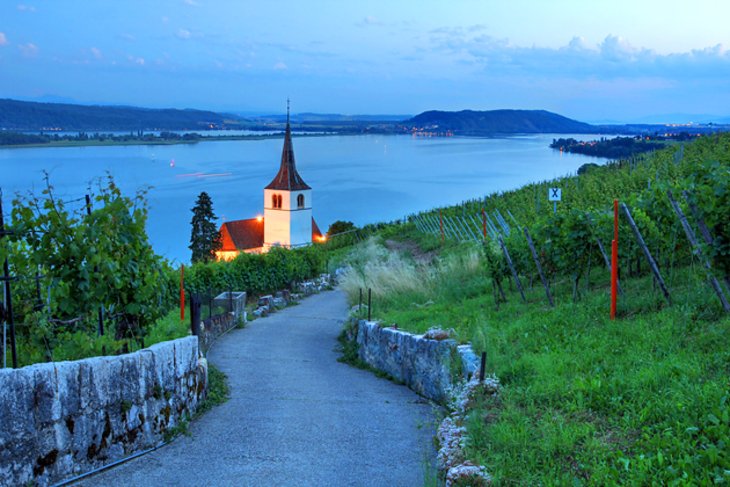Lake Biel
The Lake Biel (French: Lac de Bienne ) is, along with Lake Murten and Lake Neuchâtel, one of the three major peripheral Jura lakes of Switzerland in the so-called Three -Lakes Region. The average discharge is 244 m³ / s The theoretical residence time of water in the lake is only 54 days.
The main tributaries are the since the Jura waters correction supplied by the Hagneckkanal Aare, the upcoming Zihlkanal from Lake Neuchâtel, and the springing of the Jura streams Twannbach and bowl. The result is the Biel from the Solothurnersee, who had after the last ice age reached a length of 100 kilometers.
Shore locations
The most important town on the shore of Lake Biel is the city of Biel / Bienne. Since the Lake Biel is on the German- French language border have different towns around the lake bilingual names, which will not all be used:
- Bipschal - Bévesier
- Erlach - Cerlier
- Hagneck
- Ipsach
- Ligerz - Gléresse
- Lüscherz - Locras
- Mörigen - Morenges
- New City - La Neuveville
- Nidau
- Schafis - Chavanne
- St. Peter's Island - Île Saint- Pierre
- Sutz- Lattrigen
- Täuffelen - Chouffaille
- Tüscherz - Daucher
- Twann - Douanne
- Vinelz - Fenis
- Vingelz - Vigneules
- Wingreis - Vingras
Attractions
St. Peter's Island
The most important and most important tourist attraction of Lake Biel is the St. Peter's Island in Erlach, on which, among others, Jean -Jacques Rousseau has spent several weeks of his life. The island extends between Ligerz and La Neuveville clearly visible from the shore about 1.7 km away and can be reached by regular boat of Lake Biel Navigation Company or on foot from Erlach. The northeastern part of the front of St. Peter's Island belongs to the municipality Twann, the near-shore south-western part of the municipality of Erlach.
Excavations of the lake dwellers
The Lake Biel and the surrounding area made a very significant settlement area of the lake dwellers represents the lakeside settlements in the Alpine region are among the most important archaeological cultural heritage of Europe. Along the bank excavations and sites of prehistoric settlements are present in Sutz- Lattrigen, in Mörigen, in Lüscherz, in Vinelz in Twann and in Biel / Bienne ( in the city district Vingelz ). Some are over 6000 years old and belong to the Bronze Age or the Neolithic time. In Biel / Bienne, Lüscherz, Twann and La Neuveville are museums on this topic. The excavations of the lake dwellers of the Alps, Switzerland, Germany, Austria, Slovenia, Italy and France, a UNESCO World Heritage Site.
Viticulture at the lake
On the left bank, between Lake Biel Biel / Bienne and Le Landeron wine is grown on the steep and thus sun-exposed slopes of Jurasüdfusses. It is grown although red and rosé wines are cultivated for the most part white wine. In the autumn on the occasion of the grape harvest takes place numerous wine festivals in these places. According to a tradition, visitors are the local specialty, the Treberwurst served during the winter months in the cellars of this wine -growing region.
Conservation area and nature trail
Along the shore of the lake is located between Mörigen and Hagneckkanal an important wetland area in Switzerland, which is a nature reserve. Especially for birds of this wetland is of international importance. Many rare and endangered species breed in the near-shore and far -scale reeds and marshland, stop here during train between breeding grounds and wintering grounds or spend the winter. Due to this nature reserve and the reed belt is a nature trail.
Historical places
The town of Biel / Bienne, La Neuveville, Erlach, Twann and Ligerz have extremely well -preserved old towns or typical of the region cityscapes.







